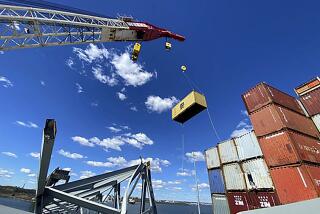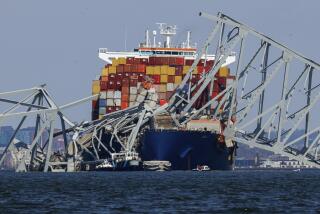Crews raise Costa Concordia cruise ship to upright position
GIGLIO, Italy — Twenty months after it capsized off the Italian coast in a disaster that killed 32 people, the Costa Concordia cruise ship emerged from the Mediterranean on Monday thanks to a painstaking $800-million salvage effort.
Fifty-six giant pulleys slowly heaved the half-submerged vessel back to an upright position in a 19-hour operation that went into the early hours of Tuesday, revealing a section of hull darkened by rust and algae during months underwater.
“The rotation has finished its course, we are at zero degrees, the ship is resting on the platforms,” said Italy’s civil protection chief, Franco Gabrielli, at a 4 a.m. news conference on Giglio island, where he was applauded and cheered by residents.
PHOTOS: Costa Concordia uprighted
“It could not have gone better than this,” said Franco Porcellacchia, an engineer working on the salvage for ship owner Costa Cruises. “It was a perfect operation.”
The 950-foot-long, 114,000-ton vessel had lain impaled on two underwater granite outcrops since January 2012, when it ran aground after Capt. Francesco Schettino attempted a “sail past” maneuver close to Giglio. Schettino is standing trial on charges of manslaughter and abandoning his ship.
About 4,200 passengers and crew were forced to scramble into lifeboats or plunge into shallow water after the ship ran aground. Thirty-two people drowned, some of them sucked under by whirlpools created as the ship tilted.
The Costa Concordia is believed to be the biggest ship to be hoisted back upright after capsizing. The technique, known as parbuckling, has been used in the past, notably on warships, including the battleship Oklahoma, which was righted by the U.S. military in 1943 after it was bombed during the 1941 attack on Pearl Harbor.
During months of careful preparation by U.S. company Titan Salvage and its Italian partner, Micoperi, more than 1,000 bags of cement were laid underwater and six underwater platforms were built for the cruise ship to be righted onto.
“It was like being in ancient Egypt, watching the construction of the pyramids,” said Giglio Mayor Sergio Ortelli.
By noon Monday, after three hours of hauling during which the pulleys exerted 6,000 tons of pressure, the ship was wrenched free from the two granite outcrops, which had penetrated 18 feet into the hull.
Needing to rotate 65 degrees, the ship slowly turned throughout the afternoon until 11 massive metal boxes — some the height of 11-story buildings — that were welded to the exposed side of the ship touched the water.
By midnight, salvage workers based in a control center on a barge off the bow of the ship switched off the pulleys and opened valves in the boxes to allow water in at 1,000 cubic feet a minute, adding the necessary ballast to bring the ship down onto the platforms.
As it rose out of the water, two large indentations could be seen on the side of the ship where it had been pinned to the rocky outcrops.
PHOTOS: Costa Concordia uprighted
Marine biologist Giandomenico Ardizzone, who has been monitoring the seabed for the ship’s operator, Costa Crociere, noted that the vessel was being moved from rocks sloping upward to the shore to platforms about 100 feet down.
“Everyone expects the ship to rise up, but it will appear the opposite,” he said before the end of the operation. “Once it is settled, the water will rise up to Deck 7 [of the ship], which is almost at the bridge.”
When the ship is deemed stable, metal boxes will be added to the formerly submerged side of the ship. Then, water will be pumped out of the boxes on both sides, floating the vessel so it can be towed in spring to a port, probably on the Italian mainland, to be taken apart.
Fears that a slick of paint, residual fuel, small quantities of heavy metal and rotting food — including more than 3 tons of melon, more than 130 gallons of olive oil and 8 tons of beef — would emerge from the ship proved unfounded, officials said.
Looking ahead, Micoperi project manager Sergio Girotto said salvage workers would now get onboard to clean up and remove safes to restore valuables to passengers.
“I would like to strip all the cabins down to the metal to take a few thousand tons of weight off the ship, which will make it sit higher in the water and could affect the choice of port we take it to,” he said.
Ortelli, the mayor, said he was in favor of keeping the platforms, which cover an area larger than a football field, for use as an artificial reef to attract divers after the Costa Concordia departs.
Ardizzone said that during his months of diving around the ship and the platforms, he had noticed shoals of fish eyeing the structure, possibly as a future home.
Kington is a special correspondent.
More to Read
Start your day right
Sign up for Essential California for news, features and recommendations from the L.A. Times and beyond in your inbox six days a week.
You may occasionally receive promotional content from the Los Angeles Times.






